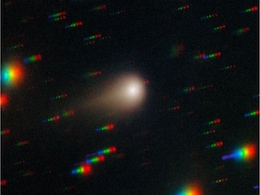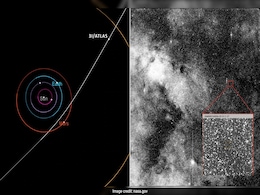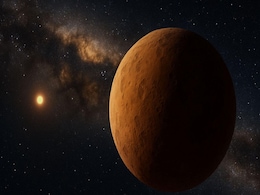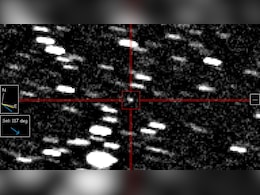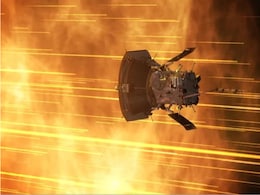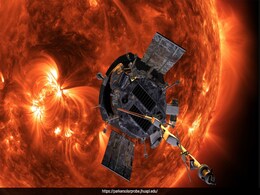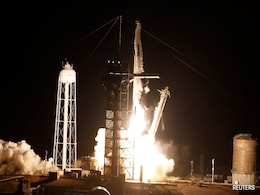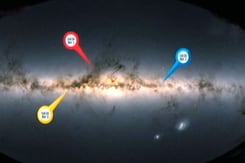Closest Sun
- All
- News
- Videos
-

Planet-Eating Stars Offer a Glimpse Into Earth’s Fate as the Sun Nears Its Final Stages
- Monday December 22, 2025
- Written by Gadgets 360 Staff
Astronomers studying aging Sun-like stars have found strong evidence that stars consume their closest planets as they evolve. Using data from NASA’s TESS mission, researchers observed fewer planets around older stars, suggesting worlds are destroyed over time. The findings offer a realistic preview of Earth’s fate billions of years from now.
-
 www.gadgets360.com
www.gadgets360.com
-

Interstellar Comet 3I/ATLAS: NASA-Approved Answers To 10 FAQs
- Thursday December 18, 2025
- Science | Edited by Srishti Singh Sisodia
NASA mentioned that the Interstellar Comet 3I/ATLAS has been approaching from the general direction of the constellation Sagittarius.
-
 www.ndtv.com
www.ndtv.com
-

Mars and Jupiter Probes Set to Monitor Interstellar Comet 3I/ATLAS During Its Sun Approach This Month
- Saturday October 4, 2025
- Written by Gadgets 360 Staff
The European Space Agency (ESA) is keeping a close eye on the Interstellar Comet 3I/ATLAS on its journey through the solar system. A spacecraft, specially designed for the Jupiter and Mars missions, will monitor the interstellar comet. Notably, this is the third known interstellar object that has marked its way through the solar system and is conti...
-
 www.gadgets360.com
www.gadgets360.com
-

Harvard Scientist Claims Rare Interstellar Object Might Be "Alien Technology"
- Thursday July 24, 2025
- Offbeat | Edited by Srishti Singh Sisodia
The comet will reach its closest point to the Sun (perihelion) on October 29, 2025, passing just inside Mars' orbit
-
 www.ndtv.com
www.ndtv.com
-

Gemini North Telescope Spots Interstellar Comet 3I/ATLAS Racing Through Solar System
- Friday July 18, 2025
- Written by Gadgets 360 Staff
Gemini North has imaged 3I/ATLAS, the third interstellar object to enter our solar system. Larger than its predecessors and possibly older than our solar system, the comet will pass closest to the Sun on Oct. 30 before returning to deep space. Scientists worldwide are racing to gather data during its brief visit.
-
 www.gadgets360.com
www.gadgets360.com
-

Astronomers Discover 3I/ATLAS, Largest Interstellar Comet Yet Detected
- Sunday July 6, 2025
- Written by Gadgets 360 Staff
Astronomers have discovered 3I/ATLAS, the third known interstellar comet to pass through our solar system. Detected by the ATLAS telescope in Chile, it’s racing inward at 150,000 mph and will swing closest to the Sun in October. Estimated to be 10–20 kilometers across, it is likely the largest interstellar object observed so far. Signs of comet...
-
 www.gadgets360.com
www.gadgets360.com
-

NASA Detects 'Interstellar Visitor' Hurtling Through Solar System
- Thursday July 3, 2025
- World News | NDTV News Desk
The comet-like body, designated 3I/ATLAS, is hurtling towards the Sun at a speed of over 60 kilometres per second
-
 www.ndtv.com
www.ndtv.com
-

Summer Solstice 2025: When Is The Longest Day Of Year & What Does It Mean?
- Friday June 20, 2025
- Offbeat | Edited by Nikhil Pandey
Traditionally, the solstice marks the longest day and the start of summer. The event has fascinated civilisations for thousands of years.
-
 www.ndtv.com
www.ndtv.com
-

Comet 2024 G3 (ATLAS) Becomes the 'Great Comet' of 2025 with Stunning Display
- Thursday January 30, 2025
- Written by Gadgets 360 Staff
Comet 2024 G3 (ATLAS) has captured the attention of astronomers with its incredible brightness and distinct tail structure. First observed in 2024, it became the brightest comet in 18 years, and it even reached a rare feat of being visible during daylight. This comet, which passed closest to the sun in January 2025, has earned the title of "Great C...
-
 www.gadgets360.com
www.gadgets360.com
-

NASA Confirms Successful Flyby of Parker Solar Probe, Completes Closest Sun Approach
- Monday December 30, 2024
- Written by Gadgets 360 Staff
NASA's Parker Solar Probe has set an unprecedented milestone, coming 3.8 million miles from the Sun at a speed of 430,000 mph. Launched in 2018, the spacecraft has utilised Venus flybys to perfect its orbit, enabling this historic feat. With advanced technology, it endures extreme temperatures, gathering critical data about solar wind and particle ...
-
 www.gadgets360.com
www.gadgets360.com
-

Parker Solar Probe's Closest Sun Flyby Sets Records, Signal Expected Soon
- Friday December 27, 2024
- Written by Gadgets 360 Staff
The Parker Solar Probe achieved the closest-ever sun flyby on Christmas Eve, reaching within 3.8 million miles of the solar surface and travelling at 430,000 miles per hour. Scientists are now waiting for a signal expected on December 27 to confirm the spacecraft’s health. Detailed telemetry and collected data are anticipated by January 1, with o...
-
 www.gadgets360.com
www.gadgets360.com
-

NASA's Parker Solar Probe Makes Closest Ever Pass By The Sun
- Tuesday December 24, 2024
- World News | Agence France-Presse
NASA's pioneering Parker Solar Probe made history Tuesday, flying closer to the Sun than any other spacecraft with its heat shield exposed to scorching temperatures of more than 1,700 degrees Fahrenheit (930 degrees Celsius).
-
 www.ndtv.com
www.ndtv.com
-

What Time Is NASA's Parker Solar Probe Closest Sun Flyby on Christmas Eve?
- Friday December 27, 2024
- Written by Gadgets 360 Staff
On Dec. 24 at 6:53 a.m. EST, NASA’s Parker Solar Probe will achieve its closest flyby of the Sun at 3.8 million miles. The mission, part of a seven-year study, aims to uncover the mysteries of the Sun’s corona and solar wind. Travelling at 430,000 mph, the spacecraft is protected by a heat shield designed to withstand extreme temperatures. Upda...
-
 www.gadgets360.com
www.gadgets360.com
-

NASA’s Parker Solar Probe Achieves Closest Sun Flyby Ever on December 24
- Monday December 23, 2024
- Written by Gadgets 360 Staff
NASA’s Parker Solar Probe will make its closest-ever flyby of the sun on December 24, 2024, passing within 3.8 million miles of the solar surface at a speed of 430,000 mph. This marks the 22nd close encounter of the spacecraft’s mission, which aims to provide unprecedented insights into the sun’s corona and other solar phenomena. Despite extr...
-
 www.gadgets360.com
www.gadgets360.com
-

Planet-Eating Stars Offer a Glimpse Into Earth’s Fate as the Sun Nears Its Final Stages
- Monday December 22, 2025
- Written by Gadgets 360 Staff
Astronomers studying aging Sun-like stars have found strong evidence that stars consume their closest planets as they evolve. Using data from NASA’s TESS mission, researchers observed fewer planets around older stars, suggesting worlds are destroyed over time. The findings offer a realistic preview of Earth’s fate billions of years from now.
-
 www.gadgets360.com
www.gadgets360.com
-

Interstellar Comet 3I/ATLAS: NASA-Approved Answers To 10 FAQs
- Thursday December 18, 2025
- Science | Edited by Srishti Singh Sisodia
NASA mentioned that the Interstellar Comet 3I/ATLAS has been approaching from the general direction of the constellation Sagittarius.
-
 www.ndtv.com
www.ndtv.com
-

Mars and Jupiter Probes Set to Monitor Interstellar Comet 3I/ATLAS During Its Sun Approach This Month
- Saturday October 4, 2025
- Written by Gadgets 360 Staff
The European Space Agency (ESA) is keeping a close eye on the Interstellar Comet 3I/ATLAS on its journey through the solar system. A spacecraft, specially designed for the Jupiter and Mars missions, will monitor the interstellar comet. Notably, this is the third known interstellar object that has marked its way through the solar system and is conti...
-
 www.gadgets360.com
www.gadgets360.com
-

Harvard Scientist Claims Rare Interstellar Object Might Be "Alien Technology"
- Thursday July 24, 2025
- Offbeat | Edited by Srishti Singh Sisodia
The comet will reach its closest point to the Sun (perihelion) on October 29, 2025, passing just inside Mars' orbit
-
 www.ndtv.com
www.ndtv.com
-

Gemini North Telescope Spots Interstellar Comet 3I/ATLAS Racing Through Solar System
- Friday July 18, 2025
- Written by Gadgets 360 Staff
Gemini North has imaged 3I/ATLAS, the third interstellar object to enter our solar system. Larger than its predecessors and possibly older than our solar system, the comet will pass closest to the Sun on Oct. 30 before returning to deep space. Scientists worldwide are racing to gather data during its brief visit.
-
 www.gadgets360.com
www.gadgets360.com
-

Astronomers Discover 3I/ATLAS, Largest Interstellar Comet Yet Detected
- Sunday July 6, 2025
- Written by Gadgets 360 Staff
Astronomers have discovered 3I/ATLAS, the third known interstellar comet to pass through our solar system. Detected by the ATLAS telescope in Chile, it’s racing inward at 150,000 mph and will swing closest to the Sun in October. Estimated to be 10–20 kilometers across, it is likely the largest interstellar object observed so far. Signs of comet...
-
 www.gadgets360.com
www.gadgets360.com
-

NASA Detects 'Interstellar Visitor' Hurtling Through Solar System
- Thursday July 3, 2025
- World News | NDTV News Desk
The comet-like body, designated 3I/ATLAS, is hurtling towards the Sun at a speed of over 60 kilometres per second
-
 www.ndtv.com
www.ndtv.com
-

Summer Solstice 2025: When Is The Longest Day Of Year & What Does It Mean?
- Friday June 20, 2025
- Offbeat | Edited by Nikhil Pandey
Traditionally, the solstice marks the longest day and the start of summer. The event has fascinated civilisations for thousands of years.
-
 www.ndtv.com
www.ndtv.com
-

Comet 2024 G3 (ATLAS) Becomes the 'Great Comet' of 2025 with Stunning Display
- Thursday January 30, 2025
- Written by Gadgets 360 Staff
Comet 2024 G3 (ATLAS) has captured the attention of astronomers with its incredible brightness and distinct tail structure. First observed in 2024, it became the brightest comet in 18 years, and it even reached a rare feat of being visible during daylight. This comet, which passed closest to the sun in January 2025, has earned the title of "Great C...
-
 www.gadgets360.com
www.gadgets360.com
-

NASA Confirms Successful Flyby of Parker Solar Probe, Completes Closest Sun Approach
- Monday December 30, 2024
- Written by Gadgets 360 Staff
NASA's Parker Solar Probe has set an unprecedented milestone, coming 3.8 million miles from the Sun at a speed of 430,000 mph. Launched in 2018, the spacecraft has utilised Venus flybys to perfect its orbit, enabling this historic feat. With advanced technology, it endures extreme temperatures, gathering critical data about solar wind and particle ...
-
 www.gadgets360.com
www.gadgets360.com
-

Parker Solar Probe's Closest Sun Flyby Sets Records, Signal Expected Soon
- Friday December 27, 2024
- Written by Gadgets 360 Staff
The Parker Solar Probe achieved the closest-ever sun flyby on Christmas Eve, reaching within 3.8 million miles of the solar surface and travelling at 430,000 miles per hour. Scientists are now waiting for a signal expected on December 27 to confirm the spacecraft’s health. Detailed telemetry and collected data are anticipated by January 1, with o...
-
 www.gadgets360.com
www.gadgets360.com
-

NASA's Parker Solar Probe Makes Closest Ever Pass By The Sun
- Tuesday December 24, 2024
- World News | Agence France-Presse
NASA's pioneering Parker Solar Probe made history Tuesday, flying closer to the Sun than any other spacecraft with its heat shield exposed to scorching temperatures of more than 1,700 degrees Fahrenheit (930 degrees Celsius).
-
 www.ndtv.com
www.ndtv.com
-

What Time Is NASA's Parker Solar Probe Closest Sun Flyby on Christmas Eve?
- Friday December 27, 2024
- Written by Gadgets 360 Staff
On Dec. 24 at 6:53 a.m. EST, NASA’s Parker Solar Probe will achieve its closest flyby of the Sun at 3.8 million miles. The mission, part of a seven-year study, aims to uncover the mysteries of the Sun’s corona and solar wind. Travelling at 430,000 mph, the spacecraft is protected by a heat shield designed to withstand extreme temperatures. Upda...
-
 www.gadgets360.com
www.gadgets360.com
-

NASA’s Parker Solar Probe Achieves Closest Sun Flyby Ever on December 24
- Monday December 23, 2024
- Written by Gadgets 360 Staff
NASA’s Parker Solar Probe will make its closest-ever flyby of the sun on December 24, 2024, passing within 3.8 million miles of the solar surface at a speed of 430,000 mph. This marks the 22nd close encounter of the spacecraft’s mission, which aims to provide unprecedented insights into the sun’s corona and other solar phenomena. Despite extr...
-
 www.gadgets360.com
www.gadgets360.com




